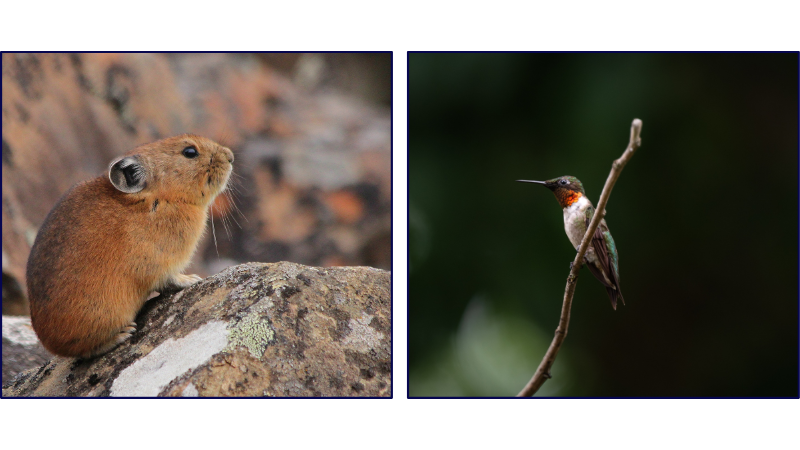Climate Action
Humanity is Destroying Its Own Habitats
September 19, 2023
From temperate forests and tundras to deserts and marshes, the United States is a vast country with many different kinds of ecosystems. These ecosystems provide us with resources naturally that would otherwise cost us $125 to $145 trillion a year to maintain. This includes food production, clean air and water, carbon capture, as well as landscapes for tourism and recreation.
However, each of these ecosystem services are threatened by the progression of climate change and the continuance of other harmful human practices, such as logging and pollution. This is because they are disrupting natural regulatory cycles as well as killing plants and animals.
Effects on Plants & Animals
In general, as the temperature of the Earth increases, populations of species globally will begin to shift northwards, around 3.8 miles per 10 years, and upwards in elevation to alleviate the heat stress. If species are not able to shift their habitat northwards or upwards, their populations may reduce or go extinct. The pika, a hamster-like mountainous animal, is climbing about 4.75 ft per year to escape the heat, but is quickly running out of available height on the mountain.
This elevated temperature will also change the timing of certain species’ natural schedule. Northeastern birds are migrating 13 days earlier than usual and 16 out of 23 studied butterfly species have also begun to migrate earlier. Why is this important? Because birds like the ruby-throated hummingbird may starve to death as their food sources may not be available earlier in the season.

Climate change also encourages the growth of many invasive species, as they are better able to adapt to changing temperatures and outcompete native neighbors. Infamous examples of this are ‘murder hornets’ (officially named the Northern Giant Hornet) and the lionfish in the northern Atlantic. These invasives feed on our essential pollinators, honey bees and Floridian reef fish respectively.
Other anthropogenic, or human-sourced, pollutants like fertilizer and plastics also deeply affect the US’s marine environments. Red algae blooms fueled by fertilizer run-off cause mass marine organism deaths from toxins and decreased available oxygen. It also harms our industries, as fishing and tourism are not possible during blooms.
Similarly, plastics are directly damaging marine ecosystems. Microplastics and microfibers rapidly accumulate in marine environments, which can lead to fish deaths, and seabirds mistake colorful pieces of plastic as food leading them to die from clogged digestive systems.
The Destruction of Our Livelihoods
Farming and food availability has been suffering from the increase in global temperature through heat damage and droughts. This has led to an estimated 21% global loss in productivity, and will cause an increase in food prices by up to 3.2%. Challenges in food production will only increase as climate change progresses. Furthermore, the fishing industry will take a big hit as fish shift their habitats northwards because of warming ocean temperatures. There is also a projected 47% loss of coldwater fish, such as salmon and trout, because warming river and lake temperatures destroy their habitats.
Ocean acidification will cause stress to shellfish populations, leading to the loss of hundreds of millions of dollars.
Trees act as natural air conditioning, cooling their surroundings with shade from their leaves. But, since 1990, 420 million hectares (or 20.79%) of forests have been demolished. This loss of trees is exacerbating the already rising heat through the absence of shade and the decreased carbon capture. Each year, one tree captures 48 pounds of CO2, so every tree lost to logging contributes to the greenhouse effect. The progression of logging and deforestation will continue to decrease the rate in which trees filter our air of CO2 and our water of pollutants through their roots.
Natural Disasters Are On The Rise
Rising global temperatures are leading to more severe and more frequent disasters like hurricanes, floods, droughts, and wildfires that threaten humans and our ecosystems. Shifting weather patterns due to climate change are leaving some ecosystems with little precipitation and intense heat, causing droughts. These dry landscapes burn and catch fire easily, which increases the frequency and speed of wildfires.
As for hurricanes, warmer surface waters fuel storms, increasing hurricanes size and storm surge heights. Coastal habitat destruction will cause more flooding from more severe hurricanes as the natural barrier is degraded. This destruction of coastal habitats like coral reefs will also cost the recreation industry $140 billion.
What Can We Do?
Climate change threatens both our systems and essential ecosystems. And while there are threats, there are also solutions. Models show that the elimination of the use of all greenhouse gasses within the decade is essential to limit warming to 2°C, the predicted threshold for dangerous cascading effects of climate change.
On a national and global scale, supporting legislation that decreases fossil fuels and promotes green energy is one of the best ways to help reduce climate change. Acting on climate change puts pressure on legislative bodies and companies to stop using fossil fuels and invest in green energy.
Plastic pollution can also be addressed through collective action. Buying reusable alternatives discourages the production of single use plastics and investing in high-quality clothing inhibits the growth of fast fashion. It’s important to remember natural ecosystems are not only the homes of plants and animals but are our homes as well. If these ecosystems shut down or are polluted, it will not just cost animal lives, but human ones too.
Educating yourself and others on climate change, its effects, and how we can stop it is how we inspire commitment to the planet. Climate and environmental literacy is the best way to enact change as individuals and communities.